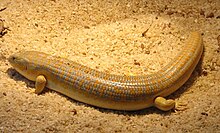
Skinks are lizards belonging to the family Scincidae, a family in the infraorder Scincomorpha. With more than 1,500 described species across 100 different taxonomic genera, the family Scincidae is one of the most diverse families of lizards. Skinks are characterized by their smaller legs in comparison to typical lizards and are found in different habitats except arctic and subarctic regions.

Cryptoblepharus is a genus of skinks, lizards in the family Scincidae. The genus contains at least 53 species.
Feylinia is a genus of skinks. It is usually placed in the monotypic subfamily Feylininae.

Lipinia is a genus of skinks, lizards in the family Scincidae. Species in the genus Lipinia are commonly called lipinias.

Mesoscincus is a genus of lizards, comprising three species of skinks native to Mexico and Central America. The species were formerly included in the genus Eumeces.

Plestiodon gilberti, commonly known as Gilbert's skink, is a species of heavy-bodied medium-sized lizard in the family Scincidae. The species is endemic to the southwestern United States and northwestern Mexico, and grows to about 7 to 12 cm in total length.
Eumeces blythianus, commonly known as Blyth's skink, is a species of lizard in the family Scincidae. The species is native to South Asia.

Eumeces schneiderii, commonly known as Schneider's skink, is a species of lizard in the family Scincidae. The species is endemic to Central Asia, Western Asia, and North Africa. There are five recognized subspecies.
Eurylepis poonaensis, the Poona skink, is a species of skink found only in Maharashtra, India.

Eurylepis taeniolata, the ribbon-sided skink, alpine Punjab skink, or yellow-bellied mole skink, is a species of skink found in Central Asia, South Asia, and West Asia. It is the type species of the genus Eurylepis.

Plestiodon is a genus of lizards in the family Scincidae (skinks). The genus contains many species formerly classified under the genus Eumeces, except those now placed in Mesoscincus. They are secretive, agile animals with a cylindrical body covered with smooth, shiny scales. They are distributed from East Asia to throughout North America from southern Canada south to Mexico, including oceanic islands such as Bermuda.
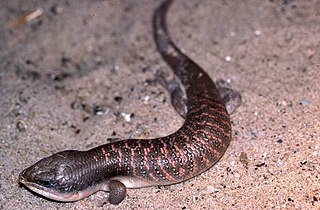
Eumeces algeriensis, commonly called the Algerian skink, Algerian orange-tailed skink, Berber's skink, in French eumece d'Algérie, or in Spanish bulán, is a species of skink in the family Scincidae. The species is endemic to the Maghreb region of North Africa.
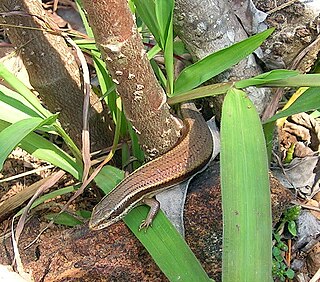
Lygosominae is the largest subfamily of skinks in the family Scincidae. The subfamily can be divided into a number of genus groups. If the rarely used taxonomic rank of infrafamily is employed, the genus groups would be designated as such, but such a move would require a formal description according to the ICZN standards.

Scincinae is a subfamily of lizards. The subfamily contains 33 genera, and the genera contain a combined total of 284 species, commonly called skinks. The systematics is at times controversial. The group is probably paraphyletic. It is one of three subfamilies of the family Scincidae, the other two being Acontinae and Lygosominae.
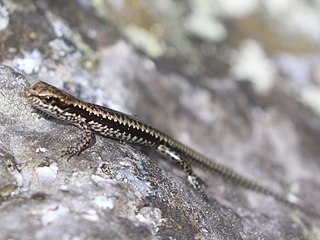
Concinnia is a genus of skinks in the subfamily Lygosominae.
The Tepalcatepec skink is a species of lizard in the family Scincidae. The species is endemic to Mexico.

Plestiodon barbouri, also known commonly as Barbour's blue-tailed skink and Barbour's eyelid skink, is a species of lizard in the family Scincidae. The species is endemic to the Ryukyu Islands (Japan).
Plestiodon copei, also known commonly as Cope's skink, is a species of lizard in the family Scincidae. The species is endemic to Mexico.

Plestiodon dugesii, also known commonly as Dugès' skink, Duges's skink, and eslabon in Mexican Spanish, is a species of lizard in the family Scincidae. The species is endemic to Mexico.
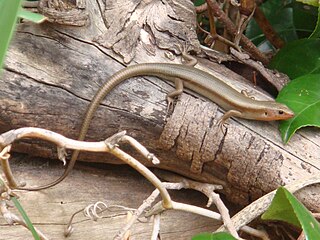
The Okada's five-lined skink or Far Eastern skink is a species of lizard which is endemic to Japan.
